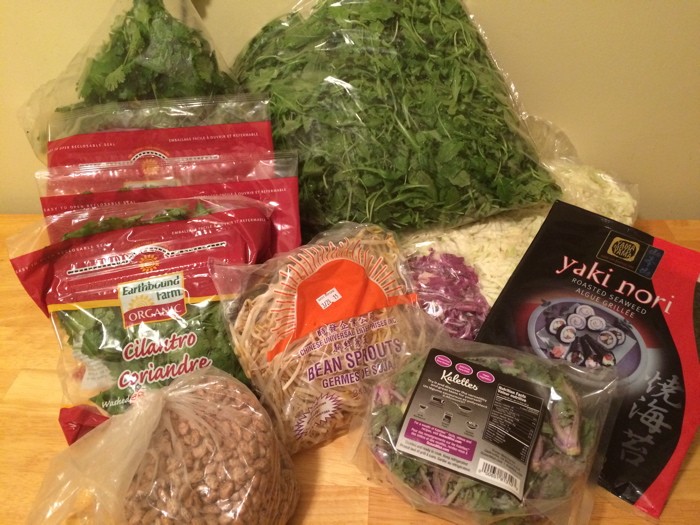Dumpster Diving 101

Haul from Rachel Barber’s first foray in urban foraging: arugula, cilantro, cabbage, kalettes, a bag of dried pinto beans, a package of nori, and some bean sprouts. Credit: Rachel Barber
Buddy up. Find out who dumpster dives regularly. Check for an online community in your town; look for maps, schedules, directions. Don’t go alone, it’s more fun in groups.
Dress down. Wear boots and grungy clothes. Be prepared to get a little dirty.
Go at night. Wait until businesses close, and bring a flashlight or, ideally, a headlamp.
Grab packs. You need something to carry back everything. Bring a large backpack, bags, or haul a bike trailer for several stops.
Persistence. It can take a while to find good stuff. Sometimes there’s so much you have to discern what to leave behind.
Location. Grocery stores that carry produce and have easy-access bins are my favourites. These tend to be chain stores in the suburbs; they’re less inclined to hide consumer leftovers. Sometimes health food and organic shops have good access, and I find they’re as wasteful as other grocers.
Food banks. They often receive more donations than they can warehouse. Due to the literal mounds of food thrown out daily, it is the most popular dig in town. And the employees here are encouraging.
Farmers’ markets. Great for fresh and tasty stuff; items are often culled for blemishes or weird consumer mentalities. One farmer said customers are less inclined to buy veggies if there isn’t a large pile of them. Weird.
Big chain drug stores. Dumpsters here have pretty good access and often have milk, yogurt, cheese, chips, nuts, granola, dark chocolate, and products nobody needs. Less fresh food here, so it doesn’t degrade as much.
Serious challenges. It’s usually tough at restaurants, grocers with meat shops, gas stations, donut shops, and dollar stores. Opaque bags makes sorting difficult, and the garbage tends to be smellier, wetter, messier, if that makes sense.
Year-round. I dumpster dive all year. Variation is mostly in the type and condition of fruits and vegetables. Meat is rarely passable in summer; winter in our city is “meat-hoarding season”; meat freezes quickly and a backyard freezer is easy and sensible. Produce doesn’t do well frozen and thawed, so I either make soup or go without.
Rescued cuisine. I can often make meals that are 50 percent rescued food, occasionally up to nine-tenths. I was practically dumpster-purist when I was a student. One time I tried to buy as little food as possible; down to $8 one month for butter, salt, and a litre of milk. A “decadent” meal included a basil and veggie cream sauce on rice, sides of cooked edamame and greek green salad, and a bowl full of fresh mango slices – only the rice being purchased. – Quincy Brandt, Winnipeg, Manitoba
Digging through garbage for food has always been a “yes, but” issue for me. I like the idea of reclaiming trash. It’s after-the-fact food justice, like harvesting a garden that others have abandoned. But the logistics of it were off-putting. Where do you go, when? And the smell, the slime, the bugs – it seemed like the ickiness outweighed the benefits.
Now my attitude has changed, I’ve learned not all dumpsters are created equal. I got a crash-course in dumpster diving from veteran “binner” Quincy Brandt. On our trip around town I scored several large bags of cilantro and shredded cabbage. Too much to keep in the fridge, so I made pesto and sauerkraut. The dive is kind of like receiving a weekly box from a farm cooperative: it can be strange or voluminous, so get creative! – Rachel Barber



Sorry, comments are closed.